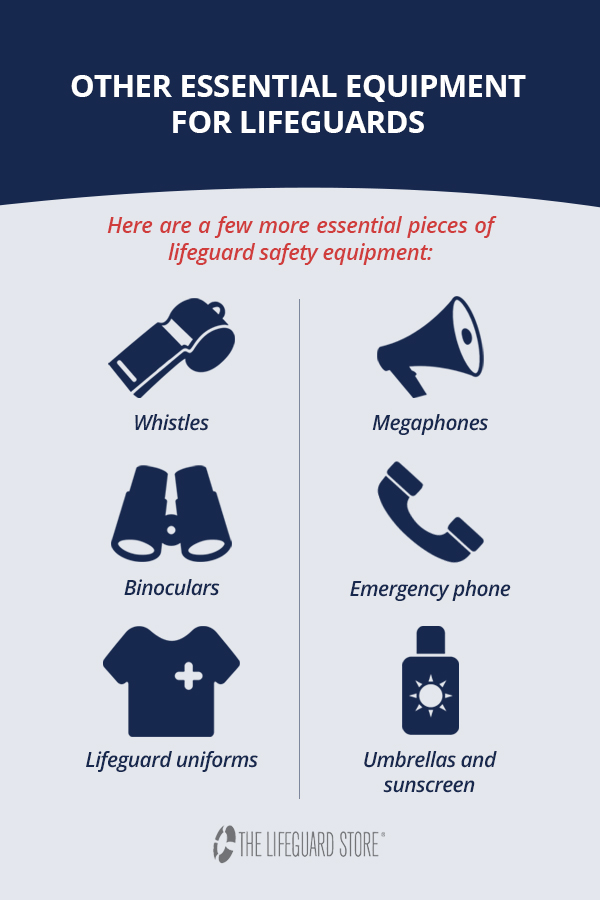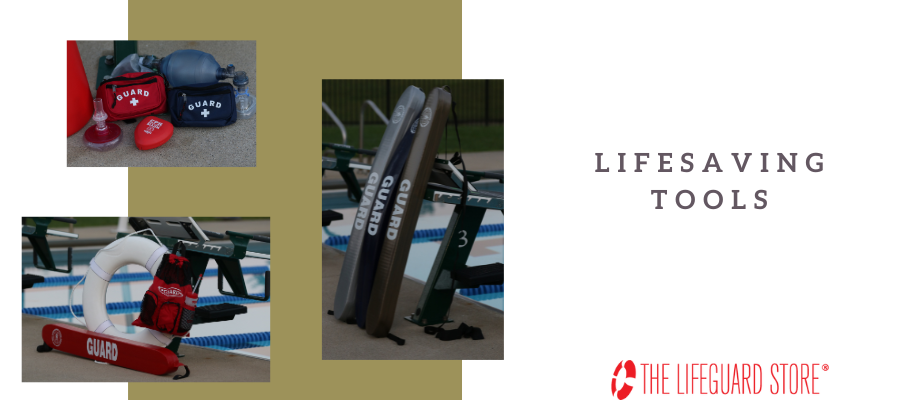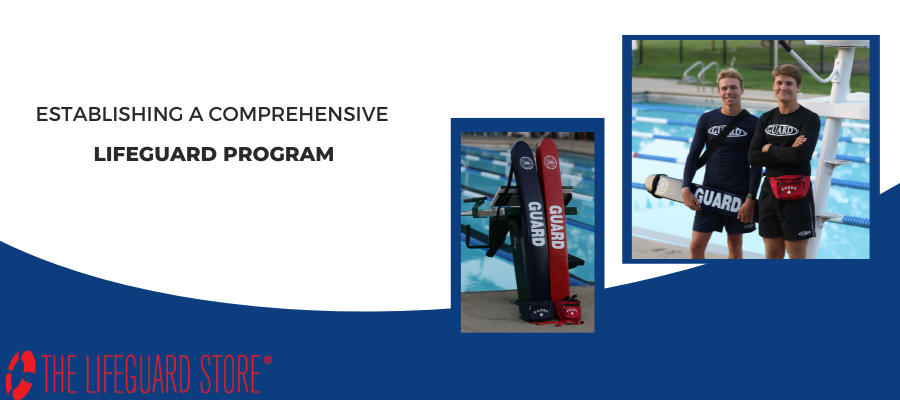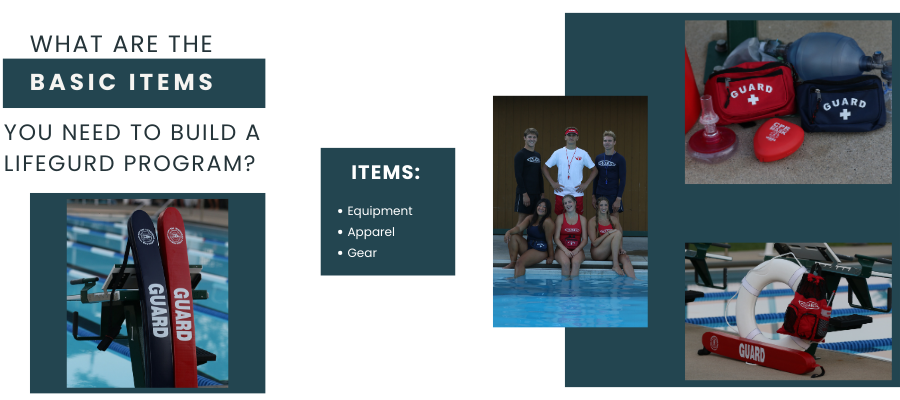Lifeguard Safety Equipment


At pools, beaches, waterparks and lakes, lifeguards take vigilant watch over swimmers and patrons and are ready to spring into action to provide life-saving care at a moment's notice. In 2017 alone, lifeguards in the United States Lifesaving Association performed 75,951 rescues at beaches around the country and administered medical attention and first aid in 546,707 instances.
To perform challenging water rescues and deliver effective medical care, lifeguards rely on the right water rescue and safety equipment. In this piece, we will cover all of the essential safety and rescue equipment lifeguards need for success in any situation.
Types of Safety Equipment Lifeguards Need
Lifeguards use various safety equipment to perform rescues, provide medical care and assist patrons. The rescue and safety equipment that lifeguards need also varies based on the water environment and the conditions of the rescue. Safety equipment for pool lifeguards can be very different than water rescue safety equipment for surf environments and rough waters.
To ensure lifeguards have everything they need to provide the best care, swimming facilities should be equipped with a wide variety of lifeguard safety equipment to address any situation. Here are some of the most important pieces of lifeguard rescue equipment and essential medical supplies that lifeguards need to keep swimmers and patrons safe in every type of water environment:
1. Rescue Tubes
This iconic piece of lifeguard safety equipment is essential for basic water rescues in pools, waterparks, lakes, ponds and other non-surf environments. Rescue tubes measure about 40 to 50 inches in length with tapered ends and a heavy-duty towline that allows lifeguards to pull them easily through the water. Made of dense foam with a durable vinyl exterior, rescue tubes are waterproof and designed to resist tears and punctures.
Each lifeguard should have their own rescue tube that can be placed across their lap while sitting or held across their stomach while standing with the towline strap around their shoulders. When swimming to a victim, a rescue tube can be held under the lifeguard's arms or torso to perform a modified breaststroke or front crawl. For longer distance rescues, the lifeguard can swim with the tube trailing behind them to reach the distressed person more quickly.
The buoyant rescue tube can then be used as a flotation device to help the victim to shore. With the victim resting on the rescue tube or with the tube wrapped around the victim's body, the lifeguard can pull the person out of the water safely. Rescue tubes can also be used as a reach assist if a distressed person is close to the edge of a pool.
2. Rescue Cans
Perfect for beaches, bays and other surf environments, rescue cans are designed for rough water rescues. Also known as rescue buoys or torpedo buoys, rescue cans are made of hard and lightweight plastic and have multiple handles that can be gripped easily from any direction. Rescue cans typically range from 25 to 35 inches in length and are able to support multiple victims. Equipped with a durable nylon cord and shoulder strap, torpedo buoys can be thrown, pulled or dragged to perform a variety of waterfront rescues.
3. Rescue Boards
Resembling a large surfboard, rescue boards allow lifeguards to perform open water rescues safely and effectively. Rescue boards are made of foam, plastic or fiberglass with a soft top for comfortable use. Lightweight and durable, rescue boards are buoyant enough to support a lifeguard and one or more victims.
When performing surf rescues, lifeguards can swim to the distressed person quickly through rough waters while laying on the rescue board. The victim can then rest on the stable board while the lifeguard paddles to shore. Rescue boards can also be used as a patrolling device to monitor the edges of swimming areas in lakes, ponds or oceans. Lifeguards can lay or stand on the rescue board and patrol using a paddle.

4. Ring Buoys
Shaped like a small inner tube, ring buoys are effective for rescues in nearly any water environment. Ring buoys are made of dense and buoyant foam, making them soft yet extremely durable and resistant to punctures. Ring buoys range from about 20 to 30 inches in diameter with grab lines on the outside for easy grip. For extended reach and easy retrieval, ring buoys can also be connected to long throw lines.
To use a ring buoy, lifeguards carefully toss the buoy to a distressed person, taking care not to hit them. The victim can hold onto the ring buoy while the lifeguard swims out to retrieve them or pulls them in using a throw line.
5. Life Hook
Also known as a shepherd's crook, a life hook can be used to rescue a distressed person near the edge of a swimming pool. Life hooks are made of flexible yet firm fiberglass shaped in a curved loop and are attached to aluminum or fiberglass telescopic poles. When reaching for a victim, lifeguards can extend the pole to the necessary length to retrieve the person swiftly.
To perform a water rescue with a life hook, a lifeguard extends the hook and tells the victim to grab onto it. If the person is unable to grab the hook, the lifeguard can dip the hook underwater to loop it under their arms and around their back. The victim can then be pulled to the edge of the pool slowly and safely.
Life hooks are not just safety equipment for pool lifeguards, but can also be used by bystanders as well. Using a shepherd's crook to rescue a person in distress is very straightforward and is often safer than entering the pool. For facilities like hotel pools that do not always have a lifeguard on duty, having a life hook on hand can prevent fatal consequences.
6. Life Vests
Life vests, or life jackets, are a familiar yet essential piece of lifeguard safety equipment. Life vests are made of highly buoyant foam with a polyester or nylon waterproof exterior. Lifeguards can provide life vests to children and inexperienced swimmers to help them stay afloat in the water. Life vests are available in a variety of sizes with adjustable belts to fit snugly and comfortably. For improved visibility in the water, life vests are available in bright colors like yellow, red, orange and royal blue.
7. Throw Bags
Designed for rescues in swift or rough waters, a throw bag is a nylon or polyester bag containing a buoyant foam disk and coiled rope. Also known as a rescue bag, this effective piece of water rescue safety equipment can be thrown to a swimmer in distress and then pulled back in to safely. While a throw bag does not serve as a flotation device, it can be used to reach victims who are far away in rough waters without endangering the lifeguard.
To use a throw bag, a lifeguard holds the end of the rescue line in one hand and tosses the bag underhand towards the victim with the other hand. The throw bag should land in the water in front of the victim where they can easily reach it. While the person holds onto the bag, the lifeguard pulls the line back in. Throw bags are often carried by kayakers or paddlers, but can also be used on other watercraft, docks or from the shore of a lake or river.

8. Backboards
Also known as a spineboard, a backboard is a life-saving piece of lifeguard rescue equipment used for victims with back, neck or head injuries or who are unconscious and unable to support themselves. Backboards are made of firm and durable plastic with hand grips that allow lifeguards to easily remove victims from the water. Spineboards are equipped with nylon body straps and a head immobilizer that protects against further injury during rescue and transportation.
Backboards should be stored in an accessible location near pools, lakes, beaches and other swimming areas. To use a backboard, lifeguards strap victims to the board and stabilize their head in the head immobilizer. The victim can then be pulled from the water safely.
9. Masks and Goggles
For long distance rescues in lakes or oceans, lifeguards can wear goggles or dive masks to protect their eyes and help them see submerged victims in murky water. Swim masks and goggles are made of durable and flexible silicone that provides a snug yet comfortable fit. Lifeguards should select goggles or masks that fit their face properly so water cannot leak into their mask during a rescue.
10. Swim Fins
Another useful piece of lifeguard equipment for long distance waterfront rescues, swim fins help propel lifeguards through the water to reach victims more quickly and reduce fatigue. Swim fins, also known as swim flippers, are made of flexible rubber and available in different sizes of blades. As with swim masks, it is essential that swim fins fit properly for effective use.
11. First Aid Kits
Pools, beaches and other swimming facilities should have first aid kits readily available to care for a variety of minor and major medical emergencies. Safety kits should contain gauze, wipes and ointments for dressing cuts, burns, scrapes and insect bites, as well as materials to wrap and stabilize injuries to bones and joints. To address heat- and cold-related emergencies, lifeguard first aid supplies should also include ice packs and emergency blankets.
12. Disposable Gloves
Lifeguards use single-use gloves to protect them from coming in contact with blood and other body fluids when assisting victims on land. Disposable gloves should be made of a non-latex material, such as nitrile, so they do not cause an allergic reaction, especially for persons who may be unable to communicate about an allergy at the time when care is being administered. Gloves should always be kept on hand in a lifeguard hip pack for easy access.
When working around hazardous pool chemicals, chemical-resistant disposable gloves should also be worn to keep lifeguards and other pool staff safe.
13. Personal Protective Equipment
In addition to disposable gloves, lifeguards may also use other personal protective equipment (PPE) such as masks, shields and gowns to protect against body fluids or other hazardous materials. For cleaning up blood, facilities must have a biohazard response kit that complies with OSHA requirements for protection from exposure to blood-borne pathogens.
14. Resuscitation Mask
Resuscitation masks are another essential piece of safety equipment for lifeguards that should always be on hand. Also known as pocket masks, resuscitation masks are small transparent masks that allow a lifeguard to breathe air into a victim without coming in direct contact with their mouth. Pocket masks create a tight seal over the victim's mouth and nose to provide air to the person quickly and effectively. Some resuscitation masks can also be connected to an emergency oxygen supply if necessary.
Pocket masks come in two different sizes for use on adults and infants. Using the correct size mask ensures a proper seal so air or oxygen can flow properly to the victim's lungs.

15. Bag Valve Masks
Bag valve masks (BVMs) are another valuable piece of lifeguard safety equipment that can be used to perform cardiopulmonary resuscitation (CPR). A bag valve mask consists of a resuscitation mask with a valve and bag attached. To use a BVM, one lifeguard holds the mask tightly over the victim's mouth and nose while another lifeguard squeezes the bag to push air into the victim's lung. Like pocket masks, BVMs come in two sizes for children and adults.
16. Oxygen Equipment
In the event of a serious cardiac or breathing emergency, lifeguards may administer emergency oxygen to a victim using an oxygen cylinder. Lifeguards attach the oxygen cylinders to a resuscitation mask with oxygen tubing to supply the right amount of oxygen necessary.
If a victim has swallowed water, a suctioning device may be needed to remove fluid from their airway before performing CPR or other life-saving care. With an easy-to-use construction, v-vac kits are an effective suction unit option for lifeguards and first responders.
17. Automated External Defibrillators
Another essential piece of lifeguard safety equipment, an automated external defibrillator (AED) can be used to care for victims who are unconscious and are not breathing. AED units deliver an electrical shock to the victim's chest to provide an emergency heart restart.
All swimming facilities should have an AED unit on hand and train lifeguards to use this equipment correctly and efficiently. Having an easily accessible AED unit at pools, waterparks and other facilities can be life-saving. According to the American Heart Association, 90% of cardiac arrest victims who receive an AED shock within 60 seconds live.
Other Essential Equipment for Lifeguards
In addition to crucial lifeguard rescue and safety equipment, lifeguards also rely on various other tools and protective equipment to address the unique needs of the water environment they are guarding and keep themselves safe. Here are a few more essential pieces of lifeguard safety equipment:
- Whistles: For pools, ponds and other smaller swimming areas, lifeguards use whistles to get the attention of patrons and to communicate with other lifeguards.
- Megaphones: For larger pools, waterparks, lakes and beaches, megaphones are often more effective than whistles at getting the attention of swimmers. Lifeguards can also use megaphones to provide directions to patrons more clearly in noisy environments.
- Binoculars: When guarding a very large area, lifeguards may use binoculars to keep a close watch on swimmers and patrons.
- Emergency phone: Swimming facilities should provide communication devices for easily connecting with local emergency medical services (EMS). Installing an emergency phone on the pool deck or another accessible location allows bystanders to call for EMS while the lifeguard performs a rescue or administers care.
- Lifeguard uniforms: Lifeguards and other swimming facility staff should wear uniforms that clearly indicate their position, whether they are a lifeguard, beach patrol personnel or pool manager. This allows patrons to quickly identify trained rescuers in an emergency.
- Umbrellas and sunscreen: If lifeguards want to keep others safe, they also have to protect themselves. Lifeguards should always wear sunscreen when outside and stand or sit under umbrellas whenever possible to protect from sun exposure.
When they are equipped with the right equipment, tools and gear, lifeguards can effectively protect beaches, lakes, pools and waterparks and provide life-saving care in any situation.

Lifeguard Equipment From The Lifeguard Store
The Lifeguard Store has everything lifeguards need to perform fast rescues and administer effective medical care in any water environment. When you need lifeguard safety and rescue equipment for your entire team, the Lifeguard Store can provide high-quality equipment at affordable prices. Browse our water rescue equipment and lifeguard equipment to outfit your lifeguarding team for success this swim season.
Learn More About Lifeguard Equipment:






Leave a Comment
Your email address will not be published. Required fields are marked *